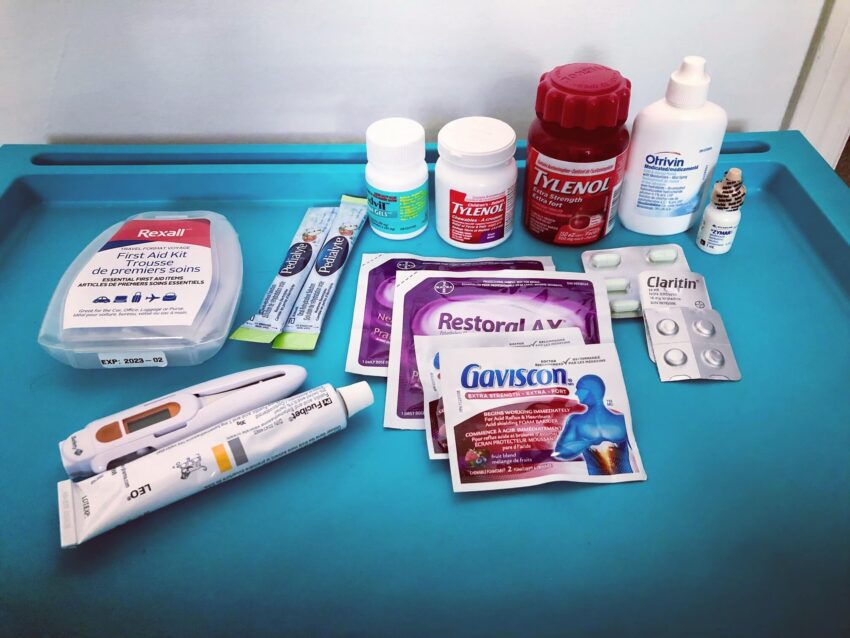What to pack in your travel first aid kit

As a healthcare professional, you might think I travel with everything and the kitchen sink; ready for any emergency, prepared to remove my own appendix like Soviet surgeon Leonid Rogozov during his Antarctic expedition.
But alas, I’m not a surgeon. That, and we generally pack light, essentials only. Thirdly, I’m of the firm belief that anything that needs more than gauze and a bandaid or cannot be treated with your typical over-the-shelf medications should be assessed by a professional.
Our travel first aid kit covers common ailments, mostly curated from personal experience (but also a little bit of professional wisdom). It’s meant for minor injuries and illnesses, to get you through a few days where you don’t feel so hot but still need to get on with adventuring. We mostly travel to family-friendly destinations, where it’s possible and decently convenient to access healthcare services if we really needed.
If you are traveling somewhere remote or there are higher risk activities on the agenda, it is always recommended to consult your local travel clinic before your trip.
I tend to think about the contents of my travel first aid kit by parts of the body that commonly act up while traveling.
Skin problems
Bandaids – this is a no brainer. For cuts and scrapes, obviously. (And also for placebo effect when the kids’ *anything* hurts. Everything needs a bandaid!)
Blister bandaids – this is KEY. I am not sure why, but every time Lil S travels she gets blisters on her feet, even wearing shoes she’s worn at home. Blister bandaids are waterproof and can stay on for several days.
Gauze – it’s good to have something thicker than just bandaids, for deeper cuts. This could be those little square packages or a little roll. If the bleeding doesn’t stop with gauze and firm pressure, time to see a doctor – you might need stitches.
Alcohol wipes – throw in a handful for cleaning the above. I have a little case to hold the wipes, gauze, and bandaids, because those little suckers migrate if not contained.
Antibiotic ointment – apply to cuts and scrapes to prevent infection.
Mild steroid cream – this is the one many people don’t consider, but it’s great for treating red itchy rashes that crop up at the worst times. You can get a rash due to heat, excessive dryness, or coming into contact with and developing a reaction to something unfamiliar, because, of course, you’re in a new place! You can usually buy a hydrocortisone 0.5 – 1% cream over the counter. In the above photo we’re bringing an antibiotic/steroid combination cream left over from a previous prescription.
Colds, flus, and allergies
They’re not the same, but all these respiratory bothers!
Medication for pain and fever – bring a generous bottle of your go to medication, acetaminophen/paracetamol and ibuprofen being the most common. We bring both, and both adult and kids versions. For achy joints, sprains, strains, headaches, etc, etc. And I kid you not, I had a weird phenomenon where randomly during my traveling, I would spike a fever for a day or two for no apparent reason. (Stress, maybe, or my body just nudging me to slow it down a bit!)
Anti-histamine – because who knows how your body will react in a new environment. You might discover an allergy you never knew you had! We recommend a non-sedating anti-histamine. In Canada, the most common are Reactine (cetirizine), and Claritin (loratadine). Benadryl (diphenhydramine) is no longer recommended, because it is sedating. Now that Big and Lil S are older, we bring adult tabs and give the kids half a tab if needed (the tabs are tiny enough for them to easily swallow). Otherwise, bring both adult and kid doses.
Nasal decongestant – I normally never recommend decongestants, because most times stuffy noses actually get worse after you stop using them. But when traveling, using decongestants for a couple of days can be a lifesaver. You don’t need to be blowing your nose all over the place, you’ll actually be able to breathe, and you’ll be able to sleep (which is key to a successful trip).
Lozenges – Sore and scratchy throats are no fun.
Antibiotic eye drops – We don’t always bring these, and when we do it’s usually leftovers from a prescription. But a small vial of Polysporin eye drops is easy to pack and can help fend off pink eye.
Thermometer – keeping track of fever (especially in the age of COVID) is always a good idea. We bring along a foldable axillary thermometer. It’s fuss free and easy to use. (The kids use this one at home too – we like to keep things simple. We do usually measure both arms as sometimes axillary readings can be less accurate.)
**If you have known severe allergies, do not forget to pack your Epi-pen! (Carry these with you at all times, as those with severe allergies already know!) You do not require special documentation to pass through airport security.
Digestive problems
Gut problems are seriously the worst when traveling. (And can be the most serious.) In addition to our over the counter remedies, we recommend that anyone traveling to developing countries for any length of time consider bringing antibiotics for traveler’s diarrhea.
We pack travel size of all these medications – they’re good to have but not frequently used, and the medications expire after a few months.
Anti-nausea medication – probably the most important of the bunch. Great for upset tummies and motion sickness. We use Gravol (dimenhydrinate). If you’re using these medications in kiddos for the first time (eg. on an airplane), make sure to try them out beforehand. Gravol is generally sedating, but in some kids they have the opposite effect and cause hyperactivity!
Heartburn medication – even if you’re not prone to heartburn, you never know what new foods might set you off. We recommend something like ranitidine, which works very quickly and is very effective.
Anti-diarrheal medication – because diarrhea is seriously the worst. We use Imodium (loperamide). If the diarrhea settles in a day or two, we continue on. But if severe or bloody or not improving, definitely time to check in to your nearest clinic.
Oral rehydration therapy – use with above, especially with kiddos who may not also want to drink tasteless water if their tummies are already upset. We do pack a few “sticks” of Pedialyte powder, but dilute juice works just as well.
Constipation medication – it’s common to become irregular when traveling. Us adults mostly just deal with it, but the kids complain of tummy pain when they’re constipated. We bring a few sachets of Restoralax (PEG 3350), which the kids use at home as well when needed.
In addition to medications, I’ve also taken to packing a very small heating pad. We bought ours off Amazon and it can be charged via USB. This is great for cramps, including period cramps, and also works for sore joints and muscles in a pinch.
We pack our first aid supplies in either a small packing cube, or a small “wet bag” (the kind you get for sweaty gym clothes).
The last item I’ll mention here is melatonin. Melatonin is a great supplement to help with sleep. It’s a natural hormone your own brain makes to regulate sleep-wake cycles. Using melatonin is great for jet leg in both kids and adults. We find 3mg works well, but you can take up to 10mg. The kids like theirs in gummy form. We don’t officially include this in our travel first aid kit because it’s a staple in our toiletries bag!



